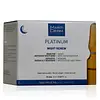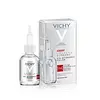What's inside
What's inside
 Key Ingredients
Key Ingredients

 Benefits
Benefits

 Concerns
Concerns

No concerns
 Ingredients Side-by-side
Ingredients Side-by-side

Water
Skin ConditioningPropanediol
SolventGlycolic Acid
BufferingLactic Acid
BufferingSodium Hydroxide
BufferingSodium Hyaluronate
HumectantCitric Acid
BufferingMalic Acid
BufferingTartaric Acid
BufferingSodium Dna
Skin ConditioningSoluble Collagen
HumectantIsoceteth-20
EmulsifyingAmmonium Acryloyldimethyltaurate/Vp Copolymer
Sodium Citrate
BufferingParfum
MaskingSodium Benzoate
MaskingPotassium Sorbate
PreservativeWater
Skin ConditioningGlycerin
HumectantHydroxyethylpiperazine Ethane Sulfonic Acid
BufferingSodium Hyaluronate
HumectantPEG-60 Hydrogenated Castor Oil
EmulsifyingWater, Glycerin, Hydroxyethylpiperazine Ethane Sulfonic Acid, Sodium Hyaluronate, PEG-60 Hydrogenated Castor Oil, Secale Cereale Seed Extract, Calcium Pantothenate, Dipeptide Diaminobutyroyl Benzylamide Diacetate, Phenoxyethanol, Chlorphenesin, Ascorbyl Glucoside, Disodium EDTA, Pentylene Glycol, Ceramide AP
Ingredients Explained
These ingredients are found in both products.
Ingredients higher up in an ingredient list are typically present in a larger amount.
Sodium Hyaluronate is hyaluronic acid's salt form. It is commonly derived from the sodium salt of hyaluronic acid.
Like hyaluronic acid, it is great at holding water and acts as a humectant. This makes it a great skin hydrating ingredient.
Sodium Hyaluronate is naturally occurring in our bodies and is mostly found in eye fluid and joints.
These are some other common types of Hyaluronic Acid:
Learn more about Sodium HyaluronateWater. It's the most common cosmetic ingredient of all. You'll usually see it at the top of ingredient lists, meaning that it makes up the largest part of the product.
So why is it so popular? Water most often acts as a solvent - this means that it helps dissolve other ingredients into the formulation.
You'll also recognize water as that liquid we all need to stay alive. If you see this, drink a glass of water. Stay hydrated!
Learn more about Water